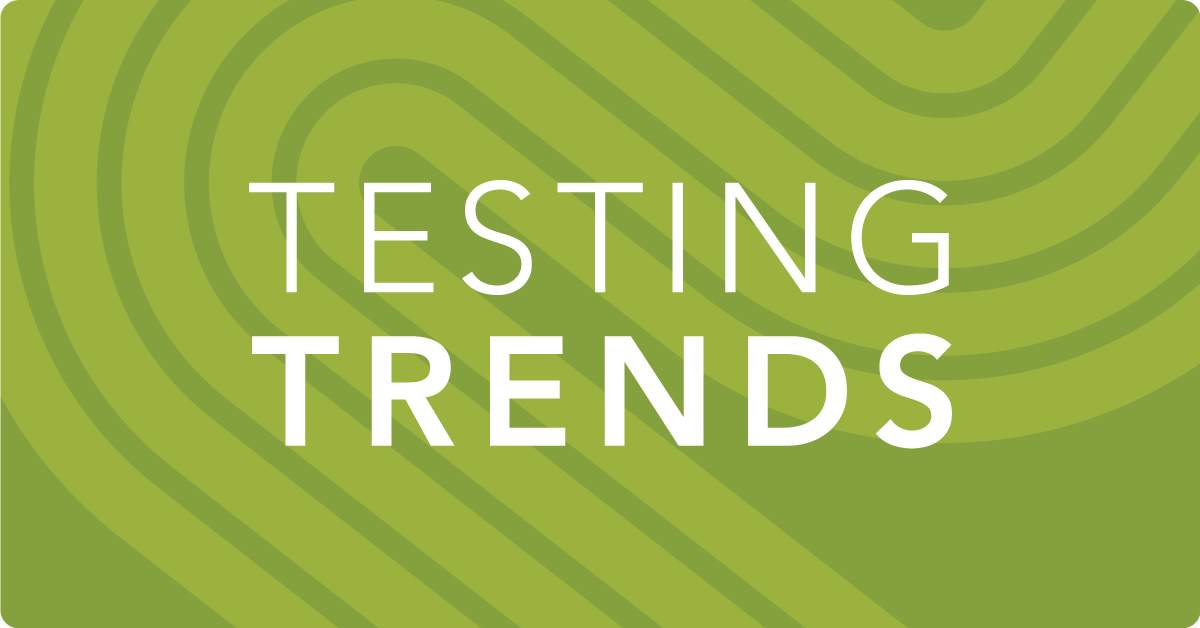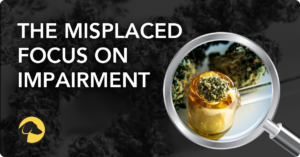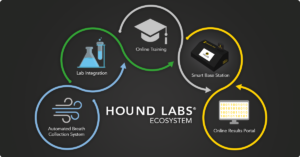
Q + A with the Experts: Drug Testing Data and the Value of Breath
The release of Quest Diagnostics’ annual Drug Testing Index™1 report produced the usual flurry of activity and responses from employers. Their feedback highlights the need for a better indicator of when cannabis use occurred and whether someone may be experiencing safety-impacting effects from workday use.
So, I interviewed two of our resident drug testing industry experts to gain more perspective. Nina M. French, Hound Labs’ President of Employer + Law Enforcement Solutions, and Aaron Atkinson, our Senior Vice President of Marketing. Together, they have more than 50 years of experience in drug testing leadership and a deep understanding of drug testing program design, technologies, policies, state laws, and federal regulations.
Here are some highlights from our interview.
As a drug testing industry veteran with more than three decades of experience, what is your main reaction to Quest’s Drug Testing Industry (DTI) report? One of the stats that stands out the most is that cannabis use is rising, hitting a 25-year high in 2022.
Nina M. French:
As more states legalize cannabis use, more people use it. Current drug tests of oral fluid, urine, and hair detect past cannabis use for days, weeks, and months, so as more states legalize cannabis and more people use it, these tests are looking back and just reflecting growing acceptance of cannabis use.
So, the increase in marijuana positivity rates2 reflects the growing acceptance and use of cannabis in our country. Many employers realize the increased positivity rates at their workplace mirror what they are experiencing – more and more qualified candidates and trusted employees are using cannabis outside of work hours – days, weeks, or months prior to testing. The employers approaching me when I speak at conferences don’t want to know about their employees’ choices after work hours.
However, these same employers are concerned that increased marijuana positivity rates could reflect employee use during work hours which could impact safety and performance. Unfortunately, unless employers use a cannabis breath test to specifically isolate workday use, positive results do not provide information to confirm an employee’s likely use during work hours.
Although not a surprise, rising cannabis use is really my key takeaway from this year’s report. And if anything, it should catalyze employers, employees, and legislators to work together to support new technology, laws, and funding that maintains safety, reduces risks, and provides cannabis test results relevant to the workday.
Year-over-year overall positivity based on urine drug tests among the general U.S. workforce increased in 9 of 15 industries reported, and not only in traditionally safety-sensitive fields. Healthcare and Social Assistance, Retail Trade, and Public Administration all reported year-over-year increases – What does this tell us about how employers should approach testing policies?
Nina M. French:
Workplace drug testing is often narrowly viewed as a safety tool. Although it is a proven tool to deter use and improve physical safety, it is, more importantly, a risk mitigation tool to keep people and business operations safe. As forward-minded employers consider all their known security risks – physical, data, brand, fiscal – they quickly realize that testing all employees and candidates is the best approach to making the most of their workplace drug testing program.
Testing not only supports workplace safety initiatives but also serves as a cost containment and risk mitigation tool – a leading indicator of a productive workplace. As states review their drug testing laws, allowing employers to test all employees – not just safety-sensitive positions – is an important consideration. With the availability of a THC breath test, employers can isolate detection to recent use and administer a fair test for all employees. As a result, they can continue to experience the benefits workplace drug testing has provided for more than four decades.
In the DTI report, Suhash Harwani, Ph.D., Senior Director of Science for Employer Solutions at Quest Diagnostics, said this: “Overall, post-accident and pre-employment positivity test rates among the federally mandated, safety-sensitive population have always been lower, suggesting the expectation of testing may be a deterrent.” Is this a surprise? How does the expectation of testing act as a deterrent?
Nina M. French:
Workplace drug testing has always been about deterrence, but that is an often-forgotten fact. In 1988, DTI statistics showed a workplace positivity rate of more than 13%. The lowest point occurred between 2010-2012 when positivity rates for all employees hovered around 3.5%. What’s interesting about the low point is that general use was surging with an increase in acceptance of cannabis ahead of legalization and the onset of the opioid epidemic in the U.S. These numbers indicate that workplace drug testing is an effective deterrent. Use was surging at that time, but employers who tested their employees experienced a reduction in positive workplace drug tests, despite a nationwide increase in usage.
How should those unfamiliar with the drug testing industry interpret the data provided in the DTI? Why is it important to understand that the DTI reflects conventional drug test types like urine?
Aaron Atkinson:
The DTI focuses on data from conventional test types, including urine, oral fluid, and hair, tests designed before the legalization of recreational cannabis use. The report is widely recognized for its consistency, depth, and breadth of data.
One of my key takeaways from this year’s report is the need for a data set that can truly be linked to workday cannabis use. Positive results from conventional tests that were designed to identify anyone who smoked cannabis within days, weeks, or months of the test no longer illustrate the entire story.
Urine testing, which represents the largest percentage of the data reported in the DTI, has long been considered the gold standard. Historically, employers leveraged urine samples to test for THC and embraced its long cannabis detection window (which can be up to 30 days) as part of their zero-tolerance testing program.
Today, however, some employers face challenges around recruitment and retention due to the inability of some conventional sample types to isolate cannabis detection to the workday. In response, some employers have removed cannabis from their testing panels or discontinued testing altogether. From a DTI perspective, this move somewhat skews the data, as the overall positivity rates would likely be significantly higher had those employers continued to test for cannabis. This is important context for interpreting data in the report and understanding why new data linked to workday use can help tell a more relevant story in the era of cannabis legalization.
Unsurprisingly, there appears to be a correlation between state legalization of cannabis and increased positivity rates. How does this impact workplace testing for cannabis in those states?
Aaron Atkinson:
The DTI separates the data between general workforce and federally mandated safety-sensitive tests – and categorizes it by factors such as geography, industry, and reason for the test. Clearly, the data confirms that legalization leads to increased use, which leads to higher positivity rates. This can also be observed across industries – in which all 15 industries reported an increase in marijuana positivity from 2021 to 2022. The report also revealed a gap between the general workforce and federally mandated safety-sensitive roles, with lower positivity rates among the federally mandated safety-sensitive positions. This suggests the expectation of testing may be a deterrent to use.
Data shows that deterrence works, and a recent use test can help employers deter use impacting work hours without penalizing an employee’s use off-the-job and away from work. It’s not surprising that employees and the unions that represent employees are also calling for a solution to specifically address workday cannabis use; they don’t want to be injured at work, and they don’t want to be unfairly disciplined for off-duty cannabis use.
In 2022, post-accident marijuana positivity in urine drug tests in the general U.S. workforce was 7.3%, an increase of 9% compared to 2021. The new peak follows a steady increase in post-accident marijuana positivity every year from 2012 to 2022. In that 10-year time frame, post-accident marijuana positivity increased 204.2%. From 2002 to 2009, post-accident marijuana workforce positivity declined. Why are we seeing a shift from the early 2000s, when post-incident positivity declined, to the last decade, when it’s steadily increasing?
Aaron Atkinson:
Let’s start with the early 2000s. It’s important to remember that recreational cannabis was not yet legal, and thus, fewer people were using it. Less use logically corresponds with less positivity. Additionally, since it was illegal, zero-tolerance drug testing programs were the norm. As we mentioned previously, drug testing deters drug use, and in the early 2000s, employers were actively testing for cannabis throughout an employee’s tenure and acting on the results. As such, it stands to reason employers may have been hiring fewer cannabis users in the first place.
Fast forward to the last decade. Legalization has rapidly increased, and so has the number of people using cannabis. We’ve heard firsthand from employers that increasing cannabis use among job applicants is creating a hiring hurdle. Here’s a recent quote from an employer customer in the construction industry:
“We just had a hiring event. Nearly 70 people showed up, and after we told them they would be tested for THC, most didn’t show up the next day, and a few failed the drug test. We lost 100% of our candidates that day.”
At the same time, some employers have reacted to these hiring challenges by eliminating pre-employment testing. It’s therefore likely employers are hiring exponentially more active cannabis users than they were a decade ago and possibly exposing their workplace to the safety-impacting effects of cannabis use during the workday. Thus, it is not at all surprising that we’re seeing a rapid increase in post-accident cannabis positivity.
This trend is translating to an increase in safety incidents as well. According to a 2021 survey by the National Safety Council,3 more than half of employers experienced an increase in incidents and a decline in performance after discontinuing cannabis testing.
It’s really the perfect storm.
And it’s exactly where cannabis breath testing comes into play. With the shortest detection window of any drug test type, breath testing solves one of the most complex and unintended challenges of rapid cannabis legalization: accurately differentiating between potentially high-risk workday use and largely irrelevant off-the-job cannabis use. With breath testing, employers have a new tool in their arsenal to help detect and deter workplace accidents. When deployed properly, we expect that companies will not only see a decrease in post-accident test positivity, but they’ll also see fewer safety incidents in the first place – which is one of the goals of every drug testing program.
GET MORE RELEVANT DRUG TESTING DATA WITH BREATH TESTING
Thank you to Nina and Aaron for providing these insights.
Companies that contact Hound Labs often share the same struggles the DTI data indicates. These companies – from Fortune® 100 to small regional businesses – are desperate to both start and reinstate cannabis testing, but they need a cannabis test designed specifically for the era of cannabis legalization with a detection window that isolates workday use. In addition to providing test results tied to workday cannabis use, the HOUND® CANNABIS BREATHALYZER will also finally provide more complete data so the entire drug testing industry can understand the complete story behind positivity rates.
Click here for more information on the HOUND® CANNABIS BREATHALYZER.

June 15, 2023
By JENNY LYNN
Co-Founder
Share












